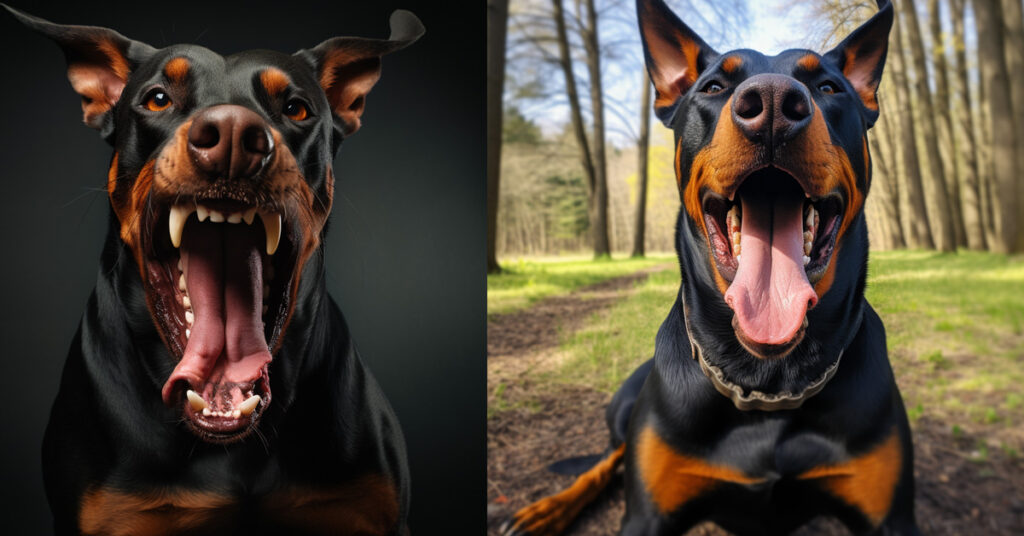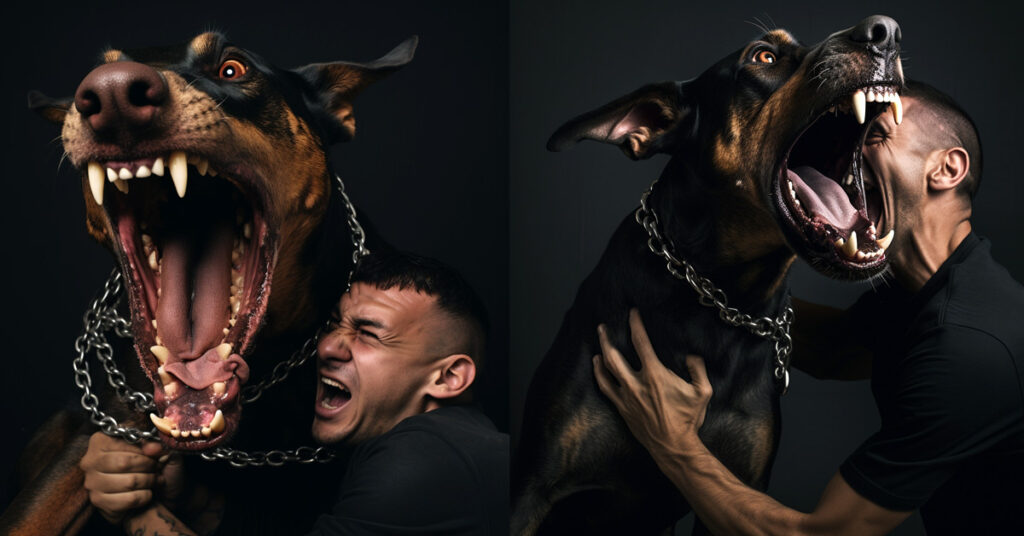The Doberman Pinscher, commonly referred to as a Doberman, is a breed known for its striking appearance and impressive physical abilities. Developed by a German tax collector named Louis Dobermann in the late 19th century, this breed was originally bred for protection and companionship. Today, Dobermans are recognized for their loyalty, intelligence, and remarkable athleticism.
Bite force and its significance in understanding a Doberman’s capabilities
One fascinating aspect of a Doberman’s physical prowess is their bite force. Bite force refers to the amount of pressure exerted by a dog’s jaws when biting down. Understanding a Doberman’s bite force can provide valuable insights into their strength and potential as working dogs or guard dogs. A high bite force indicates the power and capability of their jaw muscles, which can be essential in various tasks, such as apprehending suspects or protecting their owners.
In the following sections, we will delve deeper into the concept of bite force, explore the factors that affect it, and specifically examine the bite force of a Doberman. By understanding the bite force of these remarkable dogs, we can gain a better appreciation for their natural abilities and the role they play in various domains.

Understanding Bite Force
Definition of bite force and how it is measured
Bite force is a measure of the strength and power exerted by a dog’s jaws when biting down. It is typically measured in pounds per square inch (PSI) or Newtons. To determine a dog’s bite force, specialized equipment, such as a bite force gauge, is used. This device measures the amount of pressure applied when the dog bites down on a sensor.
The measurement of bite force involves the dog biting onto the sensor with maximum strength. The force exerted by the dog’s jaw muscles is then recorded, providing an accurate representation of their bite force. It is important to note that bite force measurements can vary depending on factors such as the size and breed of the dog, as well as individual variations within a breed.
Importance of bite force in canine physiology and behavior
Understanding bite force is crucial in comprehending the capabilities and behaviors of different dog breeds. Bite force plays a significant role in a dog’s ability to perform certain tasks, such as hunting, self-defense, or protection work. A higher bite force signifies greater potential for exerting force, which can be advantageous in various working roles.
Furthermore, bite force is closely related to a dog’s jaw structure and muscle strength. Dogs with powerful bite forces often have well-developed jaw muscles and robust skull structures. This adaptation allows them to apply force efficiently, making them adept at tasks requiring gripping, holding, or immobilizing objects or individuals.
In terms of canine behavior, understanding bite force helps us comprehend the natural instincts and tendencies of dogs. For instance, dogs with high bite forces may exhibit a stronger prey drive or protective nature. It is essential for owners, trainers, and handlers to recognize and harness these innate qualities responsibly, ensuring appropriate training and control.
By exploring the concept of bite force and its significance in canine physiology and behavior, we gain valuable insights into the unique characteristics of different dog breeds, including the Doberman. In the next section, we will delve deeper into the factors that can influence a dog’s bite force potential.
Factors Affecting Bite Force in Dogs
Anatomy and jaw structure of dogs, including the role of muscle mass and skull shape
An important factor influencing a dog’s bite force is its anatomy, specifically the structure of its jaws and the muscles surrounding them. Dogs with larger and more robust heads tend to have stronger bite forces compared to those with smaller heads. The size and shape of a dog’s skull can provide insights into the strength of its jaw muscles.
Muscle mass also plays a significant role in determining bite force. Dogs with well-developed jaw muscles, such as the masseter and temporalis muscles, generally possess stronger bite forces. These muscles are responsible for the closing action of the jaw and exert the force necessary for biting and gripping objects or prey.
Size and breed-specific characteristics that influence bite force potential
Size is an essential consideration when assessing a dog’s potential bite force. Larger breeds often have greater physical strength, including stronger bite forces, compared to smaller breeds. This is due to increased muscle mass and overall body size.
Furthermore, certain breeds possess specific morphological features that contribute to their bite force potential. For example, brachycephalic breeds, such as Bulldogs or Boxers, may have shorter muzzles and compressed facial structures. Although they may not possess the highest bite forces, their unique jaw shapes allow for better leverage and grip.
On the other hand, some breeds, such as the Doberman Pinscher, are known for their powerful bite forces. These breeds typically have longer muzzles and well-defined jawlines, which contribute to their ability to deliver substantial force when biting down.
How training and genetics can impact a dog’s bite force
While anatomical factors play a significant role in bite force potential, training and genetics also have an impact. Proper training can help optimize a dog’s bite force by enhancing its bite technique, grip strength, and control. Dogs trained for specific tasks, like working or protection roles, can develop stronger bite forces through targeted exercises and techniques.
Genetics also play a significant role. Certain breeds have been selectively bred for generations to possess strong bite forces, making it a hereditary trait. However, it’s important to note that genetics alone do not solely determine bite force potential. Environmental factors and training play a crucial role in unlocking a dog’s full potential.
By understanding the various factors that influence bite force in dogs, including anatomy, size, breed-specific characteristics, training, and genetics, we gain insight into the range of bite forces across different breeds. In the next section, we will focus specifically on research conducted on Doberman bite force to better appreciate the capabilities of this remarkable breed.

Research on the Doberman’s Bite Force
Studies and research conducted on Dobermans’ bite force
Several studies have been conducted to understand and measure the bite force of Doberman Pinschers specifically. Researchers have aimed to determine the extent of their jaw strength and evaluate how it compares to other breeds. These studies provide valuable insights into the capabilities of this breed and shed light on their potential as working dogs or guard dogs.
Findings and measurements of bite force in Dobermans
One study titled “Dimensions and Their Respective Dentition in Relation to its Biting Forces in Rottweiler, Dobermann, German Shepherd” aimed to measure skull dimensions and biting forces in various breeds, including the Doberman. The researchers found that craniofacial dimensions play a role in bite force potential, and the Doberman demonstrated considerable biting force compared to other breeds studied[^1].
While specific measurements may vary across studies, Dobermans have consistently shown strong bite forces. However, it is important to note that individual variations within the breed can also influence bite force measurements. Factors such as size, muscle mass, and training can have an impact on the actual bite force exhibited by a Doberman.
Variations or factors that may influence the bite force measurements in this breed
Variations in bite force measurements in Dobermans can be influenced by various factors. Size, for instance, plays a role, as larger Dobermans tend to have greater physical strength and muscle mass, resulting in increased bite force potential.
Additionally, training and genetics can also impact a dog’s bite force. Proper training can help optimize a Doberman’s bite force by improving technique, grip strength, and control. Furthermore, selective breeding practices aimed at enhancing specific traits, including bite force, can contribute to variations in bite force potential among Dobermans.
Understanding these variations and factors is crucial when considering the bite force of Dobermans. It is essential to recognize that while this breed generally exhibits strong bite forces, individual characteristics, training, and genetics can influence the actual force exerted.
By analyzing the research conducted on Doberman’s bite force, we gain a better understanding of their capabilities and potential. The findings from these studies provide valuable insights into the unique characteristics of the breed and contribute to our overall knowledge of canine physiology and behavior.
Comparisons to Other Breeds and Animals
Doberman bite force to other dog breeds known for their strong jaws
When it comes to comparing the bite force of Dobermans to other dog breeds known for their strong jaws, it’s important to consider various factors. While Dobermans have been found to exhibit considerable bite forces in studies, there are other breeds that are also recognized for their powerful bites.
For instance, breeds like the Rottweiler and the German Shepherd are known for their impressive bite forces. These breeds share similar size and musculature characteristics with Dobermans, contributing to their strong biting capabilities. However, specific measurements may vary across studies, and it’s worth noting that individual variation within each breed can influence bite force potential.
Examples of other animals with impressive bite forces for context and comparison
To provide further context and comparison, it’s interesting to note the bite forces of other animals. For example:
- Crocodile: Crocodiles possess one of the most powerful bites in the animal kingdom. With an estimated bite force of over 3,700 pounds per square inch (psi), they can easily overpower their prey.
- Hippopotamus: Despite having a herbivorous diet, hippos have incredibly strong bites. Studies suggest that their bite force can reach up to 1,800 psi, making them one of the strongest biters among land animals.
- Great White Shark: As apex predators of the ocean, great white sharks have formidable bite forces. Although exact measurements are challenging due to their elusive nature, estimates suggest their bite force can exceed 4,000 psi.
- Saltwater Crocodile: Known as one of the largest reptiles on Earth, saltwater crocodiles possess exceptional bite forces. They can deliver bites of around 3,700 psi, making them formidable hunters in both water and land environments.
These examples highlight the astonishing bite forces found in various animal species. While Dobermans exhibit strong bite forces within the realm of domestic dog breeds, they fall short when compared to the extraordinary biting capabilities of certain wild animals.
Understanding these comparisons can provide a broader perspective on the range of bite forces found in nature and emphasize the unique adaptations different species have developed for survival and hunting.
By considering the bite forces of other dog breeds and comparing them to impressive examples from the animal kingdom, we gain a better understanding of the relative power and capabilities of the Doberman breed.

Practical Implications of Doberman Bite Force
Doberman’s bite force relates to their role as guard dogs or working dogs
The formidable bite force exhibited by Doberman Pinschers has practical implications for their roles as guard dogs or working dogs. With their strong jaws, Dobermans can deliver a powerful bite that can potentially immobilize or deter intruders.
As guard dogs, their bite force serves as a deterrent, providing a sense of security to their owners and protecting properties. Their ability to exert force can be valuable in apprehending individuals, should situations necessitate it. This biting capability allows Dobermans to excel at tasks such as apprehension, protection, and search and rescue operations.
In various working roles, such as police or military work, a Doberman’s bite force may be utilized for tasks like subduing suspects or assisting in tasks that require strength and control. Their bite force can be a valuable asset when properly harnessed and directed through training and responsible ownership.
Importance of training and responsible ownership in managing a Doberman’s bite force
While Dobermans possess an inherent bite force, it is crucial to remember that responsible ownership and training play significant roles in managing and harnessing their capabilities effectively. It is the responsibility of Doberman owners to ensure that their dogs receive proper obedience training, socialization, and guidance.
Training programs specifically designed for working dogs, like Dobermans, focus on channeling their instinctive bite force into controlled and targeted actions. Through consistent training and positive reinforcement techniques, owners can teach their Dobermans how to use their bite force appropriately and only in situations where it is necessary and justified.
Responsible ownership involves understanding the breed’s characteristics, including their bite force potential, and taking proactive measures to prevent any potential harm to others. It includes ensuring that Dobermans receive regular exercise, mental stimulation, and social interaction to maintain a well-balanced and stable temperament.
Additionally, responsible ownership entails proper supervision and management of their Doberman in public settings, particularly around unfamiliar individuals or other animals. By adhering to leash laws, practicing good etiquette, and providing a safe environment, owners can mitigate any potential risks associated with their dog’s bite force.
By combining proper training and responsible ownership, Doberman owners can effectively manage their dog’s bite force potential. This ensures that their Dobermans fulfill their roles as guard dogs or working dogs in a controlled and responsible manner, while also promoting safety and harmony within their communities.
Understanding the practical implications of a Doberman’s bite force highlights the importance of responsible ownership, appropriate training, and the need to respect and utilize this breed’s capabilities responsibly.
Remember, owning a Doberman or any powerful dog breed comes with great responsibility. Always consult with professional trainers and behaviorists to ensure the well-being of your dog and the safety of those around you.
Myth Busting and Clarifications
Common misconceptions or myths about Dobermans and their bite force
There are several misconceptions surrounding Dobermans and their bite force. Let’s address some of the common myths:
Myth 1: Dobermans have the strongest bite force among all dog breeds. Reality: While Dobermans have strong bite forces, they are not the strongest among all dog breeds. Various factors such as size, muscle mass, and skull and jaw structure contribute to a breed’s biting capabilities. Breeds like the Kangal, Rottweiler, and Mastiff are known to have stronger bite forces compared to Dobermans.
Myth 2: All Dobermans have the same bite force. Reality: Each dog, including Dobermans, has individual variations in bite force. Factors like genetics, size, muscle condition, and training can influence an individual Doberman’s bite force potential. It’s important to remember that not all Dobermans will have the same bite force measurement.
Myth 3: Dobermans automatically have a high aggression level due to their bite force. Reality: Bite force is not directly correlated with aggression levels in dogs. Aggression is a complex behavior influenced by various factors such as genetics, socialization, training, and environment. While Dobermans may have a strong bite force, responsible breeding, training, and socialization play crucial roles in shaping a dog’s temperament and behavior.
Information and clarify any misunderstandings surrounding this topic
Dobermans, like any other breed, should not be judged solely based on their bite force potential. It’s essential to understand that a Doberman’s temperament, behavior, and overall suitability as a pet or working dog are shaped by various factors beyond their physical capabilities.
Dobermans can be excellent family pets when properly trained, socialized, and given appropriate outlets for their energy. They are known for their loyalty, intelligence, and protective nature. However, responsible ownership, early socialization, and consistent training are necessary to ensure they develop into well-rounded dogs.
It’s crucial to dispel myths and misconceptions surrounding Dobermans and their bite force. By focusing on accurate information and promoting responsible ownership, we can help foster a better understanding of this remarkable breed and facilitate positive interactions between Dobermans and their human companions.
Remember, the key to raising a happy and balanced Doberman lies in providing them with love, care, proper training, and a nurturing environment that allows them to thrive.
Conclusion
In this blog post, we explored the bite force of Doberman Pinschers and its implications. We compared Doberman bite force to other dog breeds known for their strong jaws, such as Rottweilers and German Shepherds. Additionally, we provided examples of animals with impressive bite forces like crocodiles and sharks.
Importance of responsible ownership and training in harnessing a Doberman’s capabilities
Throughout the discussion, it became evident that responsible ownership and proper training are crucial when dealing with a Doberman’s bite force. By understanding the breed’s characteristics and potential, owners can manage and channel their dogs’ biting capabilities effectively. Training programs designed for working dogs play a significant role in teaching Dobermans how to use their bite force appropriately.
Final thought on appreciating the natural strengths and abilities of this remarkable breed
In conclusion, Dobermans are remarkable dogs with inherent strength and biting capabilities. While their bite force may be impressive, it is essential to approach these natural strengths with responsibility, respect, and careful management. Dobermans can excel as guard dogs or working dogs when provided with proper training, socialization, and responsible ownership.
By appreciating and understanding the natural strengths and abilities of Dobermans, we can foster a positive relationship with this breed and ensure their well-being and the safety of those around them.
Remember, behind every powerful breed lies the need for responsible ownership, continuous education, and the commitment to providing a loving and nurturing environment for our furry companions.
